Disclosure: This post may contain affiliate links. I earn a small commission of product sales to keep this website going.
What is Zone Focusing?
Zone Focus refers to an “old” method of focusing just by estimating the distance to your subject and rotating your lens focus ring until that distance fell into a “zone” inscribed on your lens. The width of that zone is based on your aperture, which dictates your depth of field.
You’ve probably seen similar scales on some Fujifilm lenses; the 16mm f/1.4 has a scale like this.
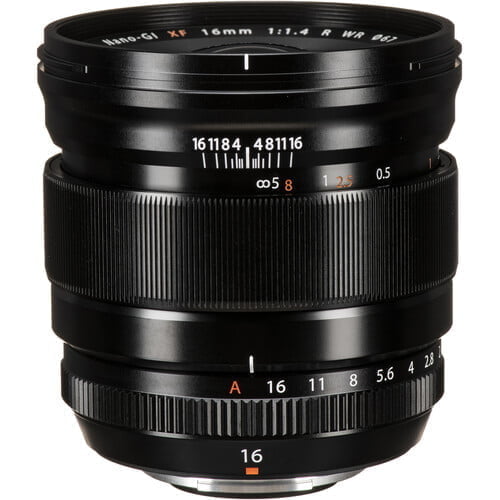
This method of focusing was the go-to before cameras had other focusing tools like prisms. But even though it was the “old” method of focusing, it’s still extremely popular among photojournalists, street photographers, and cinematographers. It’s a great tool to have in your toolbox.
Even if your lens doesn’t have a scale like this, you can still use Zone Focus with Fujifilm X & GFX cameras. We’ll take a look at how to set it up next. We also look at it in the Fujifilm Camera Fundamentals course.
How to Zone Focus with the Depth of Field Scale
Wondering how accurate these focus scales are? You can check out this experiment that I did to determine the accuracy of digital camera focus scales.
Setting up your Fujifilm camera to use Zone Focusing is really easy. We will use the Depth of Field Scale, one of Fujifilm’s many manual focus tools.
When set up correctly, this scale is on the bottom of your shooting screen. It shows your approximate focus distance and depth of field.
- The white bar is your focus distance.
- The blue bar is your depth of field at that focus distance, aperture, and focal length.
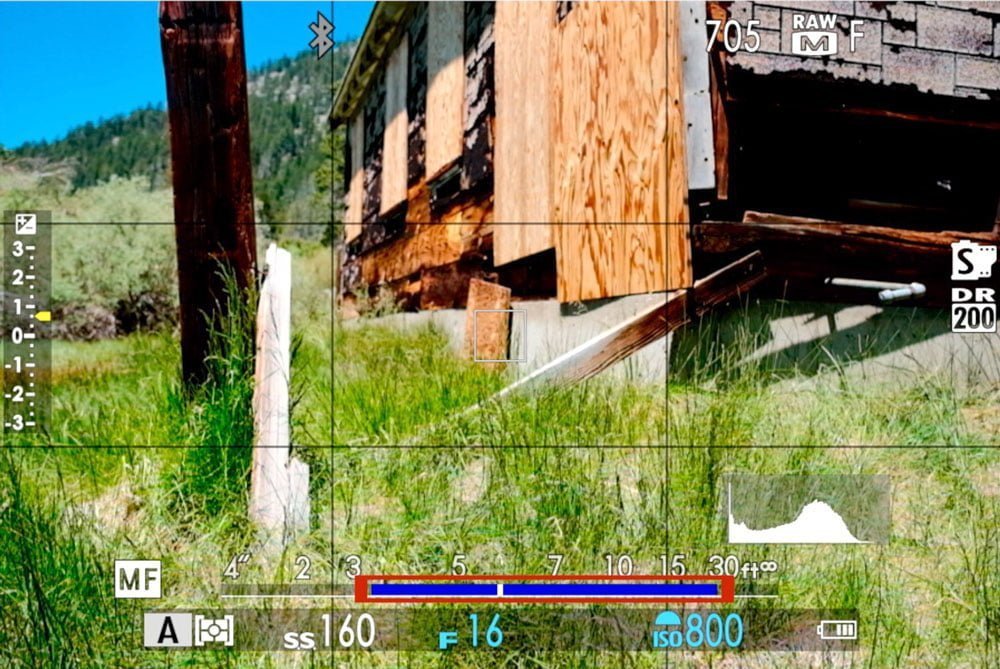
Camera Setup
First, go into the AF/MF SETTING menu. You’ll want to set DEPTH-OF-FIELD SCALE to FILM FORMAT BASIS. This will give you a deeper depth of field, a range to work in that should result in an apparently sharp photo when viewed to fit on phone screens, computer monitors, and especially prints.
The pixel basis is for you pixel-peepers. It’ll show you at what distance things will appear tack-sharp when viewed in 100% full resolution on your high-def computer screen. That’s not how normal people enjoy looking at pictures, so stop acting like it does 🙂 It’ll look just fine “fit to screen” or printed.
Next, we must check a few things in the SET UP > SCREEN SET-UP menu.
- Set your FOCUS SCALE UNITS to either Feet, or Meters for you weirdos in the rest of the world (sorry, couldn’t resist some self-deprecating measurement unit humor).
- Go to DISP. CUSTOM SETTING and make sure there’s a checkmark next to MF DISTANCE INDICATOR. You can also enable this for autofocus as well if you want to be able to check that.
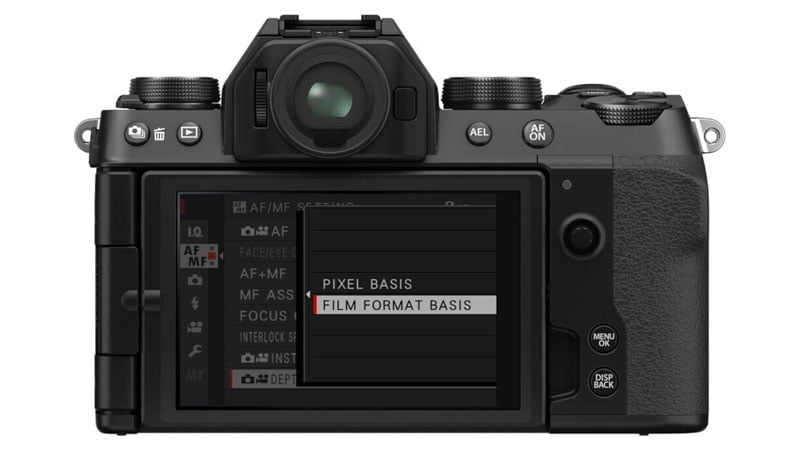
When would you use Zone Focusing?
One of the best modern-day use cases for using Zone Focus is in street photography. You have a fairly complex street scene, and people are quickly moving in and out of your frame. God knows where the autofocus is going to lock with everything going on, and you may not want to bring your camera up to your face to focus manually.
If the subjects that you want to be in focus are somewhere within a range of 10-30 feet away from you, you just set that zone to cover those distances.
In the example below, the nearest part of this old gate is 4 feet away (point 1). The farthest part is 20 feet away (point 2). I set the “zone” from about three and a half feet to just past 30 feet, and voila, it’s all in focus.
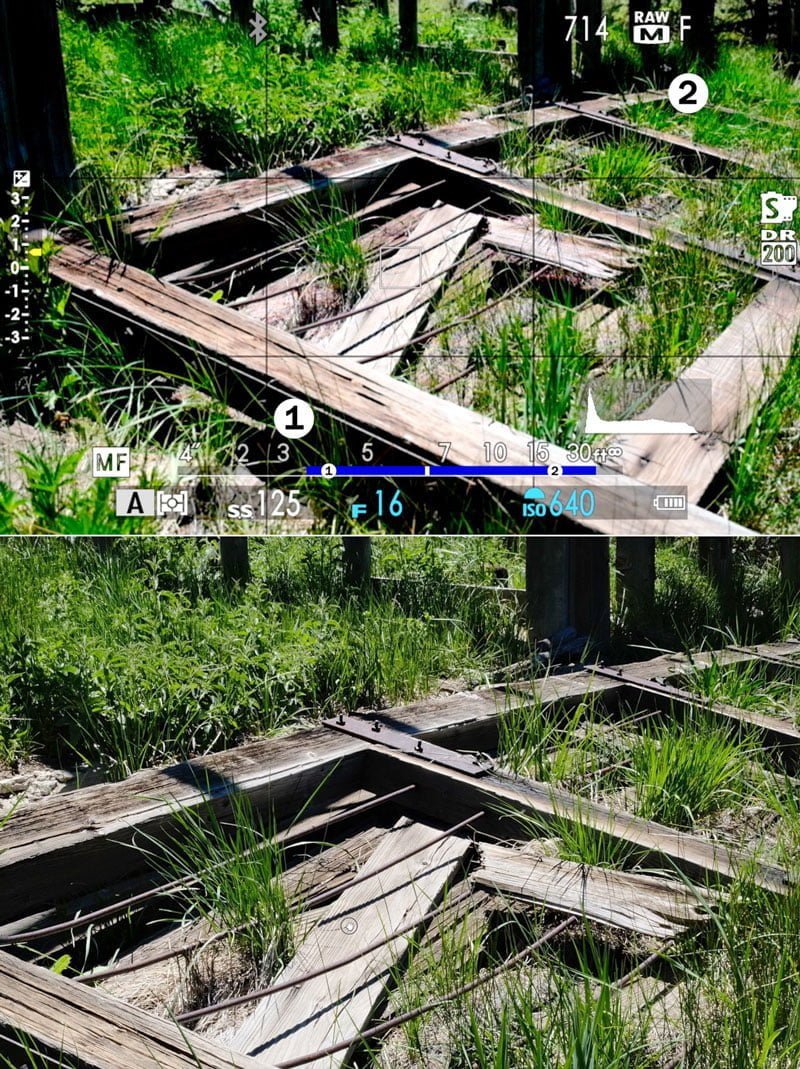
Or, if you estimate your subject to be six feet away, you can set your focus distance to six feet. Based on your aperture and focal length, you’ll then have a zone that gives you what you can think of as a margin of error. On a Fujifilm X100 with an aperture of f/8, that zone is from about 4.75 feet to 10 feet. As long as the actual subject distance is within that zone, it should appear sharp.
In the example below, I estimate the distance of this old wooden post at five feet. That’s where I set the focus distance, and the blue depth-of-field bar covers from 3 to 15 feet. The actual distance is 8 feet, within the “zone,” so it’s still in focus.
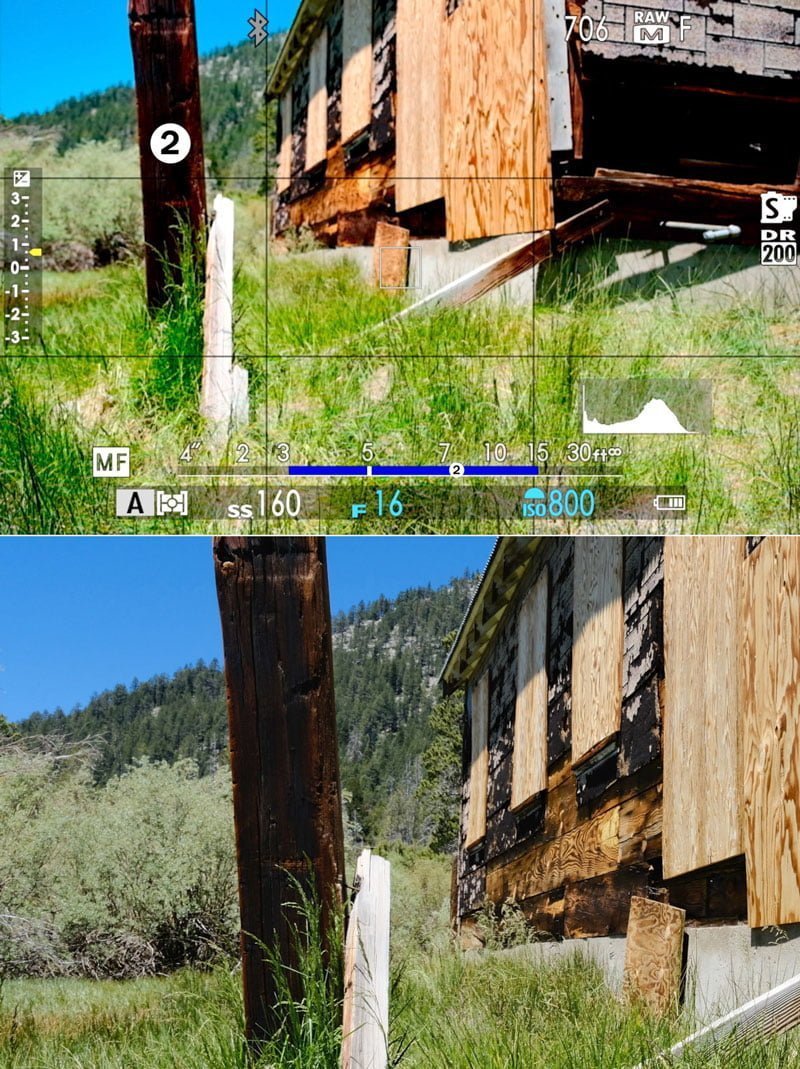
Zone focusing is also a quick way to get an idea of your hyperfocal distance and set that using the focus scale.
In the example below, I set the right side of the blue bar just to touch the infinity mark. My near depth of field limit is 4 feet, and my far limit is infinity. This is a quick way of getting the deepest possible depth of field with that aperture & focal length combination.
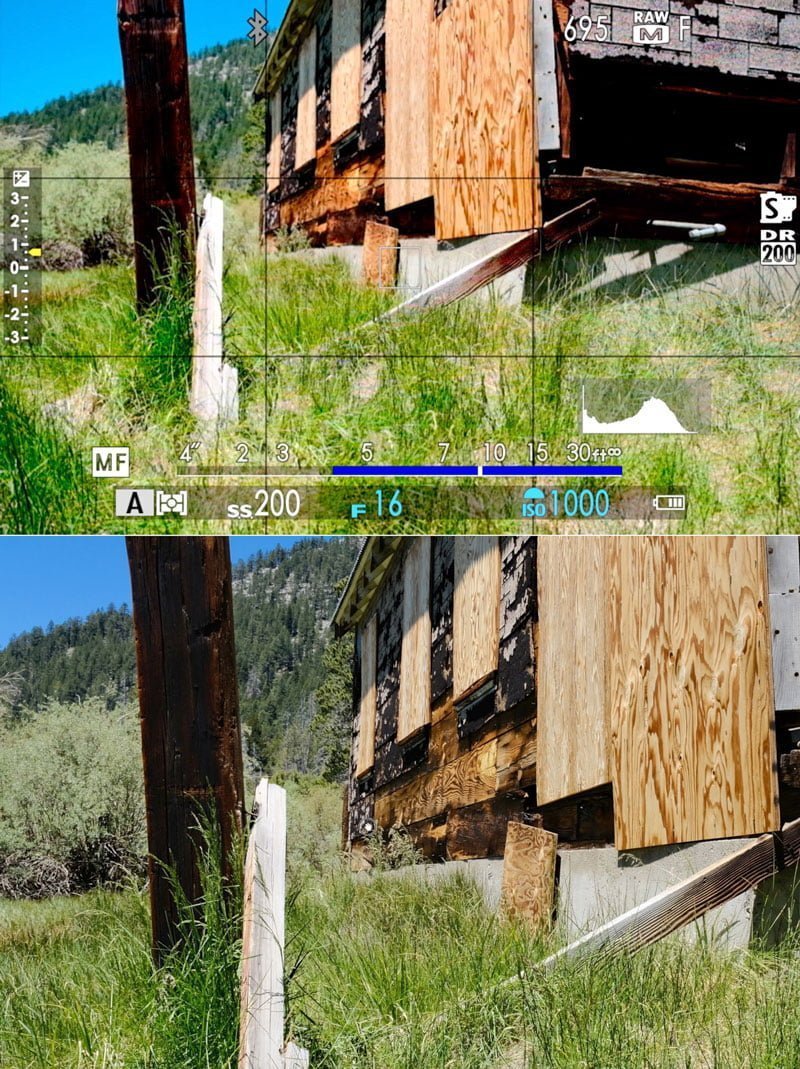
You probably do not want to use Zone Focusing when working with very close focus distances and/or long focal lengths. These situations will give you very shallow depths of field.
The whole basis of Zone Focusing is estimation, and when your depth of field is just one inch deep, estimating a subject distance of 9 inches versus 10 inches is nearly impossible. It will almost surely result in a blurry subject.
In the example below, I’m at f/4 and 50mm. My “zone” is just inches across, making estimation difficult with this wooden beam that is an actual distance of 9 feet away. I don’t have a lot of wiggle room.
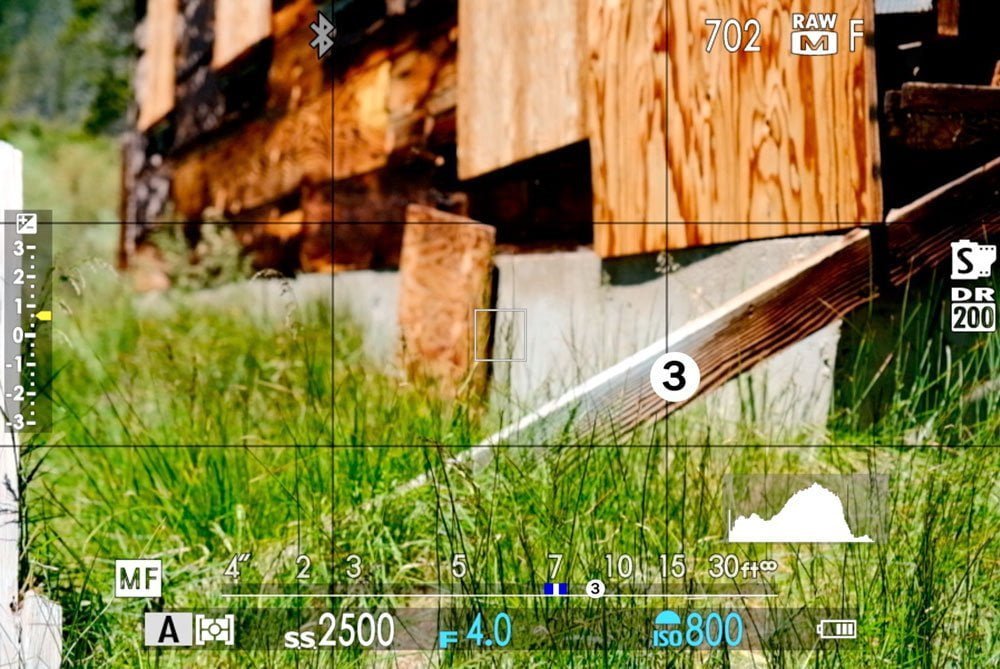
There are many times when manual focus is a better option than autofocus, and zone focus is one more manual focus tool for you to use when appropriate.
Effects of Aperture, Focal Length, and Focus Distance
There are some truths when working with zone focus, and these truths will help you get the most out of it.
Assuming nothing else changes, you’ll have a deeper depth of field – a larger zone – when you
- Stop down to a smaller aperture (larger f-number).
- Use a shorter focal length (wider lens).
- Have a further distance to the subject.
So, with that in mind, I mentioned earlier that you probably don’t want to Zone Focus when things are the opposite. And especially with all three combined. A longer focal length (like >50mm), a wide aperture (like f/1.4), and a close subject distance (like <2 feet) will make it impossible to Zone Focus. Your depth of field with those numbers is less than one inch. Good luck guessing where to drop your subject into that zone!
It’s much easier to Zone Focus using Fujifilm’s Depth of Field Scale when you stop down to about f/8 or smaller, your subject is a bit further away, and/or you’re using a wider lens, less than 35mm.
Knowing that you’ll have to stop down to use Zone Focus effectively, remember that this will probably also require you to raise your ISO, especially if you need a faster shutter speed to freeze movement. Don’t fear high ISOs! You’ll completely miss the shot otherwise if you do.
Practicing Zone Focus with Fujifilm cameras
Go out and practice this new technique of focusing!
You will guess your subject’s distance and set that distance using the white line on the focus scale. Your depth of field zone (acceptable sharpness) is the blue bar.
Here are some “drills” to get good at this:
- See how the Depth of Field scale changes as you rotate your aperture ring, rotate your focus ring, and rotate your zoom if you have a zoom lens. This will help you remember how those changes affect your depth of field (zone).
- Calibrate your eyeballs to certain distances. I’m reasonably confident I can guestimate my height for a horizontal distance, just under six feet. I also spent so much time on my 27-foot sailboat that I can guestimate that distance really well. Train yourself to guestimate a few distances like that.
- “Zone Focus” on objects at known distances – measure them out if you need to. Put that distance within different places in that zone, like at the beginning, middle, and end. See where it still looks sharp.
- Hit the streets or your backyard, or wherever else, and just zone focus over and over. Try different focus distances, apertures, and focal lengths.
The more you practice, the better you’ll get at this! Being able to set a focus zone when you don’t have the time to use other focus methods will really help you capture more memorable photos! An entire chapter of the Fujifilm Camera Fundamentals course is dedicated to different manual focus techniques if you’d like to learn more in an interactive format.
Please leave any questions or other techniques in the comments below.

Run-And-Gun Photography – SOOC shooter
Thursday 30th of March 2023
[…] of field goes all the way up to infinity. (If you’re unfamiliar with zone focusing, here’s a good primer on this technique.) Why f/8? Because this aperture setting can offer a wide depth of field, around […]
Jeremy
Tuesday 25th of October 2022
Hi John. Thanks for the well-written article.
I purchased an X-Pro3 and have taken on a 1-year challenge of 1 camera, 1 lens. I am looking for a lens with ~35mm full-frame equivalent with a focus scale on it. My goal is to manual focus without looking through the optical view finder.
Is there a lens that you would use for 1 year? I'm up for all suggestions, any brand. Thanks!
John Peltier
Thursday 27th of October 2022
Hi Jeremy, I don’t have a ton of experience with third-party lenses, but the Fuji 23mm f/1.4 is extremely popular. It has a focus scale on it. I used it for a short while and was very happy with it - but traded it in for my X100 that has a fixed lens of the same focal length.
Scott Carey
Friday 21st of October 2022
As I'm fairly new to the Fujifilm camera game, I wonder if you could help me:
Does the DOF scale work only with Fujifilm's AF lenses on fly-by-wire (when set to MF) but not with third-party MF lenses? (although said scale is still displayed)
Or, have I set up my X-T20 camera somehow wrongly?
Thanks.
John Peltier
Saturday 22nd of October 2022
Yeah, unfortunately, the scale will still be displayed with third-party manual focus-only lenses but will not show your depth of field scale. It will work on any lens with autofocus capability.
Fawwaz
Monday 17th of October 2022
Thank you John for sharing so much practical knowledge. I am a beginner photographer and your blogs have been a breath of fresh air in the sea of information out there about functions and features in modern cameras. Your blogs are helping me enjoy taking photos. Thank you for your generosity.
Charlie Hoffman
Tuesday 26th of July 2022
Good Morning John, Thank you for another well written article. I personally enjoy your incites and the ease with which you explain the process. Thank you so very much for freely sharing your knowledge and I'm looking forward to the next article. Charlie
John Peltier
Tuesday 26th of July 2022
Thank you for the feedback, Charlie!